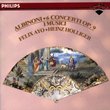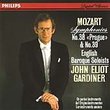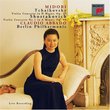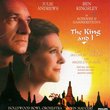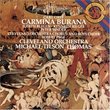| All Artists: Leon Minkus, Riccardo Drigo, Simon Streatfeild Title: Art of Prima Ballerina Members Wishing: 0 Total Copies: 0 Label: Polygram Records Release Date: 11/10/1992 Genres: Special Interest, Classical Styles: Ballets & Dances, Ballets, Historical Periods, Modern, 20th, & 21st Century Number of Discs: 1 SwapaCD Credits: 1 UPC: 028943386128 |
Search - Leon Minkus, Riccardo Drigo, Simon Streatfeild :: Art of Prima Ballerina
 | Leon Minkus, Riccardo Drigo, Simon Streatfeild Art of Prima Ballerina Genres: Special Interest, Classical
|
CD DetailsSimilarly Requested CDs
|
CD ReviewsPas de Quatre and other treasures ATP | Santa Monica, CA United States | 03/25/2003 (5 out of 5 stars) "I took me years to track down this CD. I finally acquired it as part of the boxed set, Fete du Ballet (ASIN B00005ND46) - and I had to go to Amazon UK to order it. But it was worth the extra effort just to get Pugni's "Pas de Quatre" music. If you're a ballet fan, there's something magical about listening to music created for Marie Taglioni - arguably the most renowned of the four ballerinas who danced to Pugni's music. I've had the good fortune to see the Pas de Quatre danced, and it's a delight. Like the choreography for the Fairies in The Sleeping Beauty, the Pas de Quatre shows off each dancer's strengths. The Bolero 1830 is almost as difficult to find as the Pas de Quatre. And the great thing about Fete du Ballet is that it's ten CDs of 19th century treasures." Bonynge's first recording of ballet music MrLopez2681 | USA | 10/26/2005 (5 out of 5 stars) "Richard Bonynge has been a pioneer of recording the music of the ballet composers of the 19th century, from the famous to the obscure. He began his recording career as a conductor of opera, which included the recordings of his wife, 'La Stupenda', the soprano Joan Sutherland. Through his exposure to 19th century theatrical music Bonynge developed an interest in the ballet music of the era. Afterall, Bonynge has a great deal of respect for the other kind of prima-donna: the prima ballerina. "The Art of the Prima Ballerina" was Bonynge's first venture into recording ballet music, starting off a succession of albums featuring rare and wonderful pieces written for the ballet. For "The Art of the Prima Ballerina", Bonynge collaborated with the ballerina Dame Alicia Markova to advise on the proper way to conduct such music (there are a few passages of this recording where it may appear that Bonynge has forgotten her instruction, but Markova hails from an era where dancers didn't slow music down to an insane degree). Bonynge made certain that the long-neglected 'Petit maîtres' of the ballet were represented here, among them, Cesare Pugni (1802-1870), Ludwig Minkus (1826-1917) and Riccardo Drigo (1846-1930), all of whom composed for the Imperial Ballet of St. Petersburg during the reign of Marius Petipa. A fellow ballet historian informed me that some of the material recorded here was taken from the orchestral parts used by the touring company of the legendary ballerina Anna Pavlova, preserved in the Library of Congress and the New York Public Library. At the time this recording was produced this was no doubt all that was available of some of these pieces outside of communist Russia of any orchestral version, and it is possible that Bonynge may have been forced to reconstruct some of it. "The Art of the Prima Ballerina" was orignally released on LP in 1962 (and included a cover photo of Alicia Markova in her costume for "Pas de quatre"), and was re-released in 1992 as part of the Decca/London label's 7 CD "Ballet Gala" series that featured many of Bonynge's other offerings of rare ballet music: "Pas de Deux", "Homage to Pavlova", "Invitation to the Dance", "Ballet Music from Opera", "Massenet: Le Cid; Meyerbeer: Les Patineurs", and "Adam: Le Diable à quatre; Ballet Music & Entr'actes". Unfortunately the series went out-of-print in 1996. In 2001 Decca/London Records compiled most of the recordings for the 10 CD boxed-set "Fête du Ballet: A Compendium of Ballet Rarities" (Decca 468 578-2).
The first piece presented here is of excerpts from the famous scene "The Kingdom of the Shades" from Petipa's 1877 ballet "La Bayadère". Unfortunately the liner notes do not give the listener a résumé of the numbers included. Recorded here is: --Grand adage --Variation I --Variation II --Variation III --Variation de Nikiya, a.k.a. the "Scarf duet" --Grand coda (with a tacked-on epilogue borrowed from the proceeding tableau) The composer of "La Bayadère" was Ludwig Minkus, who held the post of official 'Ballet Composer to the St. Petersburg Imperial Theatres' from 1871 until 1886. During his association with the Imperial Theatres he composed over 20 ballets for the Balletmasters Marius Petipa and Arthur Saint-Léon and adapted already-existing music for Petipa's numerous revivals. The material from "La Bayadère" presented on this disc - being a shortened version of the celebrated scene "The Kingdom of the Shades" - is a re-orchestrated version of Minkus's music that was originally created for Anna Pavlova's touring company. Although the music was prepared the production never materialized for reasons unknown to me. The liner notes do not mention anything about the origins of this edition of the music, and it doesn't credit whomever was responsible for this particular orchestration, which is colorful to say the least, with lots of decoration that makes it night and day when compared to Minkus's original, simple style. The 'Grand coda' includes a tacked-on epilogue of music that is taken from the music Minkus wrote for the proceeding tableau (this music is not heard in most modern-day productions, but is included in the Kirov/Mariinsky Ballet's recent reconstruction of Petipa's 1900 revival of "La Bayadère"). The version of the music of the "The Kingdom of the Shades" found on this disc is also included in Bonynge's recording of John Lanchbery's (1923-2003) adaptation of Minkus's full score for "La Bayadère", which was prepared for Natalia Makarova's 1980 staging for American Ballet Theatre (see Decca 436 917-2). (NOTE - Also available is a recording by Boris Spassov and the Sofia National Opera Orchestra of "The Kingdom of the Shades" scene from "La Bayadère" in the orignal orchestrations of Minkus. See CD Capriccio 10 544). The next piece offered in this suite is a fantastic piece by Riccardo Drigo (1846-1930) titled simply as "Pas de trois". Once again the liner notes don't give us a scrap of information concerning the orgins of this piece. Recorded here is: --Entrée et adage --Variation --Variation (by Cesare Pugni) --Coda This piece was originally arranged by Drigo for the legendary ballerina Mathilde Kschessinskaya when she performed the title role in the brothers Sergei and Nikolai Legat's 1903 staging of the ballet "Die Puppenfee" ("The Fairy Doll") for the Mariinsky Theatre. "Die Puppenfee" was originally staged in 1888 by the Ballet Master Joseph Hasseiter to the music of Josef Bayer for the Court Opera Ballet in Vienna. The Kirov/Mariinsky Ballet still perform this extract on occasion as a concert piece, while the full-length "The Fairy Doll" is performed here and there by the Vaganova Academy. Recently this pas has become a popular extract around the world on the gala and competition circuit. In its traditional staging, this piece serves as a 'pas d'action' for three dancers: two pierrots and the Fairy Doll herself. The pierrots quarrel in an attempt to "out dance" one another in an effort to impress her. It's possible that this pas was not composed by Drigo as a unit, but was brought together from pieces taken from various works. In Tsarist Russia it was standard practice for the music of a novelty pas-de-whatever to be set to music brought together from various sources (the music of the so-called "Le Corsaire" pas de deux and "La Esmeralda" pas de deux were assembled in the same way). The Grand adage is very neopolitan in its melody and orchestration for two softly played trumpets and a solo violin. It is possible that the adage is an expression of the Commedia dell'Arte, expressing the moonstruck romance of Pierrot. As far as orchestration goes, the pas as presented on this disc is a very stripped down version of Drigo's original, lush arrangement, with many missing parts for various instruments. Suprisingly the music does not suffer one bit from this, and still demonstrates Drigo's obvious Italian musical heritage and his incredible talent for creating beautiful, singing melodies. A pretty big dissapointment is the omission of the original variation for the lead ballerina of this pas (a delightful number for pizzicato, harp and glockenspiel), and instead a piece extracted from Cesare Pugni's original score for Petipa's 1862 "The Pharaoh's Daughter" is put in its place (Pierre Lacotte's 2000 version of "The Pharaoh's daughter" does not include it). Anna Pavlova typically performed this solo in place of the original one (there is a famous film of her performing it). (NOTE - the DVD "Kirov Classics" includes a spectacular performance of "The Fairy Doll" pas de trois by the dancers Larissa Lezhnina, Dmitri Gruzdev and Yaroslav Fadeyev of the Kirov/Mariinsky Ballet. Lezhnina performs the original variation for the lead ballerina, and the music is presented as orignally composed by Drigo, though the film erroneously credits Joseph Bayer as the composer.) The 3rd selection is excerpts from Act I of the 1841 ballet "Giselle". The liner notes incorrectly credit Adolphe Adam as the composer responsible for the all of the pieces offered here when he is in fact only reponsible for the 'March de vignerons'. Recorded here is: -March des vignerons -Variation de Giselle, a.k.a. Pas seul (likely by Riccardo Drigo) -The so-called "Peasant pas de deux" (Burgmüller): --Entrée --Adage --Variation I --Variation II --Variation III --Coda The 'Variation de Giselle' or 'Pas seul' han long been thought to be the work Ludwig Minkus. Ivor Guest's liner notes for Bonynge's recording of Adam's full, un-edited 1841 score for "Giselle" state that Minkus likely composed the variation for the ballerina Emma Bessone's 1887 début in Petipa's production of "Giselle". Rodney Stenning Edgecombe's article "Notes on Giselle and Paquita" (published in Dance Chronicle, Vol.22/No.3, 1999) agrees with Guest's claim that Minkus is likely the author. Interestingly, the famous 1982 documentary "A Portrait of Giselle" hosted by Sir Anton Dolin includes an interview with the great ballerina Olga Spessivtseva where it is mentioned that she brought the variation with her from Petersburg in the 1910s for her performance at the Paris Opéra. The orchestral parts used by the Royal Ballet title the variation as "Variation for Elena Cornalba", while the Sergeyev Collection at Harvard University mentions a "Variation for Elena Cornalba" among its collection of materials relating to "Giselle". Minkus had already retired almost 2 years before Cornalba was engaged at the Mariinsky Theatre - Acoms razor shows that the only composer who would have been responsible for an additional variation of this kind was Riccardo Drigo. Even when Minkus's ballet "Fiametta" was revived with Cornalba in the lead in 1887, it was Drigo, not Minkus, who composed her novelties. Drigo composed several more pieces for Cornalba as she appeared in various roles, even supplementing Mikhail Ivanov's brand-new score for Petipa's "La Vestale" of 1888. Drigo's 1889 ballet "Le Talisman", staged lavishly by Petipa, was also created especially for Cornalba. When one adds all of this up, it leaves only Drigo as the author of the famous Act I solo of "Giselle". The so-called "Peasant pas de deux" was interpolated into act I of the original production of "Giselle" in 1841 for the Ballerina Nathalie Fitzjames. As mistress of an influential patron of the Paris Opéra, her request to participate in the production was granted. Due to another engagement, Adolphe Adam was unable to compose the extra music for Fitzjames's desired pas, and an already-exsisting suite titled "Souvenirs de Ratisbonne" by the German composer Friedrich Burgmüller (1806-1874) was used. Today the "Peasant pas de deux" is included in every production of "Giselle" all over the world. For the fourth track we have more music from "Giselle" - the 'Grand pas de deux' from Act II. Presented here is a rather mild re-orchestration of the music by a composer that, of course, the CD liner notes don't mention. I think that the orchestrator is none other than John Lanchbery (one must be intimately familiar with Adam's original score even to notice the subtle changes in orchestration featured on this disc). Recorded here is: --Introduction (taken from the preceeding number) --Grand adage --Allegro --Variation d'Albert --Variation de Giselle (likely by Cesare Pugni) The full pas is recorded here, along with a little introduction taken from the preceeding number, as well as the waltz-variation for Giselle to Adam's lietmotive for Giselle and Albrecht. This is yet another interpolation for Adam's score that came about via Russian revivals, being composed in 1866 for the Ballerina Adèle Grantzow, which, like Giselle's Act I solo, has become an integral part of Adam's score. The composer responsible for this number is open to some debate, and although Minkus is often credited the elimination process leaves only Cesare Pugni as the likely party responsible - although Minkus had a written a few ballets for the St. Petersburg troupe for Saint-Leon's works in 1860s, it was Pugni who was the resident composer of ballet music, etc., and the task of composing such a piece would have certainly fallen into his hands. For the most part Bonynge conducts the music exactly as it would be for a live performance, although the last passage of the adage does not have the pauses that is featured during a live performance. The pas d'action from August Bournonville's 1836 version of the ballet "La Sylphide" is the next piece in this recording. It is often extracted from the full-length ballet and performed independently. The very first production of "La Sylphide" - which premiered at the Paris Opéra in 1832 - was created by Fillipo Taglioni for his daughter Marie and set to a score by Jean-Madeliene Schneitzhoefer. When the Danish Ballet Master August Bournonville planned to mount his own version of the ballet in Copenhagen he originally intended to utilize Schnietzhoeffer's score, but the Paris Opéra demanded too high a price for a copy of the orchestral parts. Undeterred, Bournonville commissioned a completly new score from the composer Herman Severin Løvenskiold (1815-1870). The pas de deux recorded here takes place at the beginning of Act II of the ballet, in which the Sylph dances with James, and subsequently the enitre retinue of her sister Sylphs join in. Unfortunatly Bonynge conducts the music entirely to fast, particularly at the start. (NOTE - There are 2 recordings available of Løvenskiold's complete score for "La Sylphide", the first is conducted by Harry Damgaard with the Danish Radio Symphony on the label CPO Records and currently out-of-print. The second recording is by David Garforth and the Royal Danish Orchestra on the label Chandos and is still available). The next piece offered in this suite is of the very rarely recorded so-called "Black Swan pas de deux" from "Swan Lake". Recorded here is: --Entrée --Grand adage (ending revised by Riccardo Drigo) --Variation traditionally danced by Prince Siegfried (fashioned from the omitted allegro ending of the adage) --Variation d'Odile (arranged by Drigo from Tchaikovsky's Op.72 for piano, no.18 "L'espiègle") --Grand coda Many people who have purchased recordings of the full-length "Swan Lake" are often confused as to why the music offered does not correspond to the music heard in the theatre. Most productions of "Swan Lake" are derived from Marius Petipa and Lev Ivanov's 1895 revival of the ballet. This revival presented a severly altered edition of Tchaikovsky's 1877 score prepared by Riccardo Drigo, and it is this version of the score that is utlized to one extent or another by most companies. Unfortunately most recordings offer Tchaikovsky's original 1877 score and not the revised version of 1895, making most balletomanes frustrated in their search for the performance score. The so-called "Black Swan pas de deux" was created by Petipa to music Tchaikovsky had originally written for Act I - a "pas de deux for two Merry Makers". The piece was tranferred to the third tableau and used as a 'Grand pas de deux demi d'action' for the characters Odile, Prince Siegfried, Von Rothbart, and an additional suitor. Riccardo Drigo modified the ending of the adage by omiting Tchaikovsky's original allegro. He then added the famillar epilogue everyone uses in the theatre today. The variation for Odile is material orchestrated by Drigo from Tchaikovsky's Opus 72 for piano (No.18 - "L'espiègle"). The variation for Prince Siegfried is fashioned from the omitted allegro ending of the adage. Interestingly, it is not taken from the Petipa/Ivanov staging - Prince Siegfried did not dance a variation in the 1895 revival, though Alexander Gorsky, who participated in the 1895 revival as the additional suitor did, though it is not known to what music he danced. Prince Siegfried's variation is historically credited to Vakhtang Chabukiani, who first performed this solo during the pas in 1931 (the Kirov/Mariinsky Ballet's score for "Swan Lake" titles this variation as "Variation Chabukiani"). Bonynge's conducting for the most part is pretty good, but the variation for Odile is conducted entirely to fast, and no ballerina would ever be able to dance Petipa's traditional choreography to such a rushed tempo. (NOTE - For a far better recording of so-called "Black Swan Pas de Deux" with superb conducting, see the CD "Pas de Deux - The Ballet Experience" performed by the Sofia National Opera Orchestra under the baton of Boris Spassov. There is a recording of the complete 1895 version of "Swan Lake" as modified by Riccardo Drigo - conducted by Victor Fedotov with the Mariinksy Theatre Orchestra AKA the Kirov Orchestra on the label Classical Records, it is a re-release of the same recording from 1997 that went out-of-print from the label JVC "The Swan Lake" JVCCC-6500-2.). Second to last is an obscure piece that likely became included on this disc at the suggestion of Markova. It is a Boléro, orginally composed for piano in 1830 by an unknown hand for the American dancer Anna Ricarda. This piece was later used by Geronimo Gimenez for the 'Boleras' from his score for the 1897 zarzuela "La Boda De Luis Alonso". Markova later resurrected this music for her own performance in an orchestration by James O'Turner. Gimenez's arrangement is far better than that of O'Turner, but the piece still does not loose its wonderful Spanish flare and charm. Bonynge really bring the piece to life, making it one of the best selections. Finally we come to the most special inclusion of this entire suite of ballet excerpts - the famous divertessment "Pas de quatre". Recorded here is: --Entrée et andante --Allégro --Variation de Mlle. Lucille Grahn --Variation de Mlle. Carlotta Grisi --Morceau d'ensemble dansée par Mlle. Marie Talgioni et Mlle. Lucille Grahn --Variation de Mlle. Fanny Cerrito --Variation de Mlle. Marie Taglioni --Coda It was Benjamin Lumley - the enterpirsing director of Her Majesty's Theatre in London - that came up with the idea of putting the four greatest Ballerinas of his time on one stage: Lucile Grahn, Fanny Cerrito, Carlotta Grisi and Marie Taglioni. The music was written by the Italian composer Cesare Pugni, who served as the official 'Composer of the ballet music' to Her Majesty's Theatre in London, where his music was essentially the "soundtrack" of the heyday of the romantic ballet. The choreographer was the great Romantic choreographer Jules Perrot, who was at that time the greatest choreographer in all of Europe. "Pas de quatre" premeiered on July 12, 1845 between acts of the opera "Anna Bolena" by Donizetti at Her Majesty's Theatre in London. It was an enormous success, so much so that the audience would not stop applauding, delaying the opera to such a degree that the lead Primadonna left the theatre, and her performance was taken over by an under-study. A funny anecdote tells of how Grahn, Cerrito and Grisi all agreed that the coveted final variation should go to the great Taglioni, but it soon became clear that Cerrito and Grisi desired to dance the preceeding variation, which would in essence make that danseuse inferior only to the great Taglioni. Originally it was planned for Fanny Cerrito's variation to be placed before Carlotta Grisi's (the original orchestral parts reflect this). A rivary between the ballerinas soon followed, and it reached such heights that the performance was almost aborted entirely. Benjamin Lumley then had a simple solution - the order of variations preceeding Taglioni's would be determined by age, from youngest to oldest. When appraoched with this idea, the ballerinas began to giggle with shyness - the last thing that the prima-donna Ballerinas would do is reveal thier real ages, and the firey rivalry was soon put out. In the end, it was indeed age that determined the order of variations! Pugni's music is typical of his compositions for the ballet: beautiful, instant melodies all orchestrated in an extremely interesting and colorful fashion. The music is phrased and paced perfectly for ballet, and, as has often been observed, the music is almost "too perfect" for ballet, in that it fits the needs of dance like a glove. It is interesting to note that the theme of Marie Talgioni's variation borrows the second air from Johann Strauss I's 1828 "Kettenbrücke-Walzer" (Chain or Suspension Bridge Waltz). Strauss wrote the waltz for the inauguration of the Kettenbrücke Suspension Bridge which spanned the Lahn River in Nassau until it was demolished in 1926. The bridge was considered a "wonder of the world" at the time, and Strauss's waltz was rather popular (a song was written to Strauss's waltz called "The Wonder of the World"). Pugni was well-known for currying favor from the ballerinas for which he wrote, and it is likely that the inclusion of an air from the waltz was merely a way of stating that Talgioni was herself a "wonder of the world". The original orchestral parts for "Pas de quatre" are retained in the Bibliothèque nationale de France, and it is rather suprising, considering the existence of these parts, that the music is always presented in a reorchestration by ballet companies throughout the world. This recording presents Pugni's music as arranged for the orchestra by William McDermott, done especially for Alicia Markova in 1951. Typically in the west, however, it is an orchestration by Leighton Lucas that most ballet-goers hear performed in the theatre, which was done in the style of Pugni especially for Anton Dolin's definitive 1941 revival of "Pas de quatre", which is still performed today. "The Art of the Prima Ballerina" is among the most sought-after recordings of ballet music ever produced. For those who do not want to pay some of the ridiculous prices some sellers are asking for this recording, it is available in its entirety in the 10 CD boxed-set "Fête du Ballet" (Decca 468 578-2)." |

 Track Listings (8) - Disc #1
Track Listings (8) - Disc #1